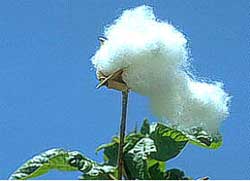 The Gossypium (cotton) genus presents a novel opportunity to advance our understanding of the natural world and organic evolution, while nurturing bio-based carbon sequestration alternatives to petrochemical use and improving the sustainability of crop production. The genus has spawned one of the world’s most important crops (cotton), which sustains one of the world’s largest industries (textiles). The value of cotton fiber grown in the USA is typically about $6 billion/yr. Cottonseed oil and meal byproducts add $500 million/yr. More than 440,000 domestic jobs are related to cotton production and processing, with an aggregate influence of about $120 billion/yr on the US gross domestic product and estimated $500 billion/yr worldwide. Increasing the durability and strength of cotton fiber offers the opportunity to replace synthetic fibers requiring more than 200 million barrels of petroleum per year to produce in the USA alone, also increasing use of bio-based products and increasing farm income. Its seed oil, and also byproducts of cotton processing, are potential biofuels.
The Gossypium (cotton) genus presents a novel opportunity to advance our understanding of the natural world and organic evolution, while nurturing bio-based carbon sequestration alternatives to petrochemical use and improving the sustainability of crop production. The genus has spawned one of the world’s most important crops (cotton), which sustains one of the world’s largest industries (textiles). The value of cotton fiber grown in the USA is typically about $6 billion/yr. Cottonseed oil and meal byproducts add $500 million/yr. More than 440,000 domestic jobs are related to cotton production and processing, with an aggregate influence of about $120 billion/yr on the US gross domestic product and estimated $500 billion/yr worldwide. Increasing the durability and strength of cotton fiber offers the opportunity to replace synthetic fibers requiring more than 200 million barrels of petroleum per year to produce in the USA alone, also increasing use of bio-based products and increasing farm income. Its seed oil, and also byproducts of cotton processing, are potential biofuels.
Cotton evolution involved a fascinating series of events that offer scientists the opportunity to dissect the evolution of a novel organ, the ‘lint fiber’, and also to unravel the consequences of polyploidy, both for the generation of biodiversity and for crop productivity. Gossypium is also ideal for ‘phylogenetic shadowing’ of the Brassicales (including Arabidopsis and Capsella), discerning otherwise cryptic genomic features such as conserved noncoding sequences. Cotton fibers, which can be produced in vitro, represent an excellent single-celled genomics platform that will accelerate the study of gene function, building on a distinguished history of seminal contributions to plant molecular biology. In particular, this may provide unique insights into cellulose biosynthesis that are fundamental to bioenergy (bioethanol) production.
Principal Investigator: Andrew H. Paterson (Univ. of Georgia)